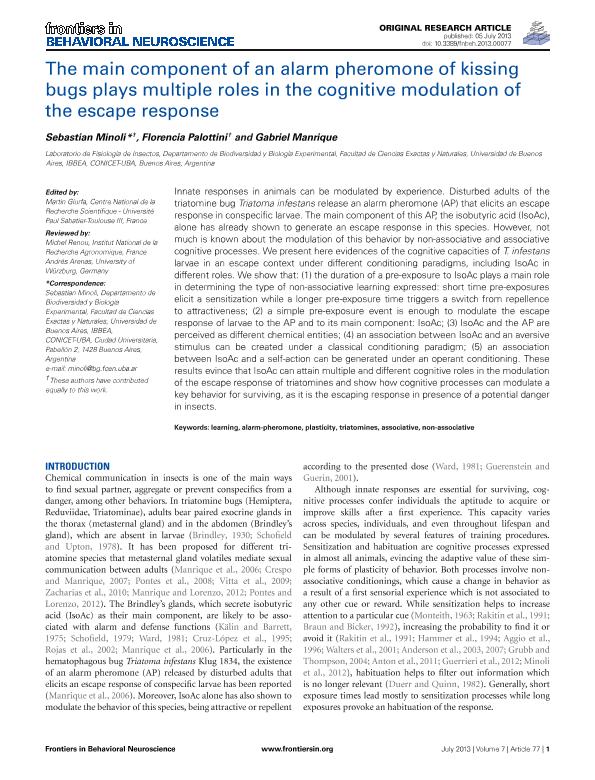Mostrar el registro sencillo del ítem
dc.contributor.author
Minoli, Sebastian Antonio

dc.contributor.author
Palottini, Florencia

dc.contributor.author
Manrique, Gabriel

dc.date.available
2017-05-02T19:21:56Z
dc.date.issued
2013-07
dc.identifier.citation
Minoli, Sebastian Antonio; Palottini, Florencia; Manrique, Gabriel; The main component of an alarm pheromone of kissing bugs plays multiple roles in the cognitive modulation of the escape response; Frontiers; Frontiers in Behavioral Neuroscience; 7; 7-2013; 1-10; 77
dc.identifier.issn
1662-5153
dc.identifier.uri
http://hdl.handle.net/11336/15883
dc.description.abstract
Innate responses in animals can be modulated by experience. Disturbed adults of the triatomine bug Triatoma infestans release an alarm pheromone (AP) that elicits an escape response in conspecific larvae. The main component of this AP, the isobutyric acid (IsoAc), alone has already shown to generate an escape response in this species. However, not much is known about the modulation of this behavior by non-associative and associative cognitive processes. We present here evidences of the cognitive capacities of T. infestans larvae in an escape context under different conditioning paradigms, including IsoAc in different roles. We show that: (1) the duration of a pre-exposure to IsoAc plays a main role in determining the type of non-associative learning expressed: short time pre-exposures elicit a sensitization while a longer pre-exposure time triggers a switch from repellence to attractiveness; (2) a simple pre-exposure event is enough to modulate the escape response of larvae to the AP and to its main component: IsoAc; (3) IsoAc and the AP are perceived as different chemical entities; (4) an association between IsoAc and an aversive stimulus can be created under a classical conditioning paradigm; (5) an association between IsoAc and a self-action can be generated under an operant conditioning. These results evince that IsoAc can attain multiple and different cognitive roles in the modulation of the escape response of triatomines and show how cognitive processes can modulate a key behavior for surviving, as it is the escaping response in presence of a potential danger in insects.
dc.format
application/pdf
dc.language.iso
eng
dc.publisher
Frontiers
dc.rights
info:eu-repo/semantics/openAccess
dc.rights.uri
https://creativecommons.org/licenses/by-nc-sa/2.5/ar/
dc.subject
Learning
dc.subject
Alarm-Pheromone
dc.subject
Plasticity
dc.subject
Triatomines
dc.subject.classification
Zoología, Ornitología, Entomología, Etología

dc.subject.classification
Ciencias Biológicas

dc.subject.classification
CIENCIAS NATURALES Y EXACTAS

dc.title
The main component of an alarm pheromone of kissing bugs plays multiple roles in the cognitive modulation of the escape response
dc.type
info:eu-repo/semantics/article
dc.type
info:ar-repo/semantics/artículo
dc.type
info:eu-repo/semantics/publishedVersion
dc.date.updated
2017-04-28T20:28:50Z
dc.journal.volume
7
dc.journal.pagination
1-10; 77
dc.journal.pais
Suiza

dc.journal.ciudad
Lausanne
dc.description.fil
Fil: Minoli, Sebastian Antonio. Consejo Nacional de Investigaciones Científicas y Técnicas. Oficina de Coordinación Administrativa Ciudad Universitaria. Instituto de Biodiversidad y Biología Experimental y Aplicada. Universidad de Buenos Aires. Facultad de Ciencias Exactas y Naturales. Instituto de Biodiversidad y Biología Experimental y Aplicada; Argentina
dc.description.fil
Fil: Palottini, Florencia. Consejo Nacional de Investigaciones Científicas y Técnicas. Oficina de Coordinación Administrativa Ciudad Universitaria. Instituto de Biodiversidad y Biología Experimental y Aplicada. Universidad de Buenos Aires. Facultad de Ciencias Exactas y Naturales. Instituto de Biodiversidad y Biología Experimental y Aplicada; Argentina
dc.description.fil
Fil: Manrique, Gabriel. Consejo Nacional de Investigaciones Científicas y Técnicas. Oficina de Coordinación Administrativa Ciudad Universitaria. Instituto de Biodiversidad y Biología Experimental y Aplicada. Universidad de Buenos Aires. Facultad de Ciencias Exactas y Naturales. Instituto de Biodiversidad y Biología Experimental y Aplicada; Argentina
dc.journal.title
Frontiers in Behavioral Neuroscience
dc.relation.alternativeid
info:eu-repo/semantics/altIdentifier/doi/http://dx.doi.org/10.3389/fnbeh.2013.00077
dc.relation.alternativeid
info:eu-repo/semantics/altIdentifier/url/http://journal.frontiersin.org/article/10.3389/fnbeh.2013.00077/full
Archivos asociados
